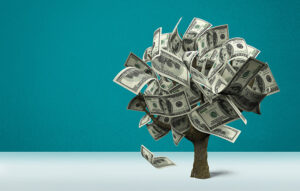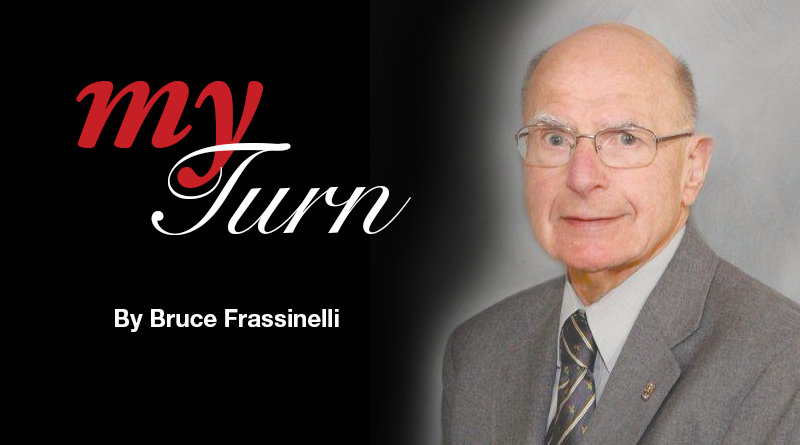Money Doesn’t Grow on Trees, You Know — or Does It?
By Bruce Frassinelli bfrassinelli@ptd.net
 When I was growing up in the anthracite coal regions of Eastern Pennsylvania, I would get a modest allowance for which I was expected to do chores around the house and at our family’s grocery store.
When I was growing up in the anthracite coal regions of Eastern Pennsylvania, I would get a modest allowance for which I was expected to do chores around the house and at our family’s grocery store.
It was so long ago, it’s hard to remember exactly how much I received, but I believe it originally was 50 cents a week, then, as I got older, $1 and, eventually, $5. I remember getting $10 a week spending money for my first year at college at a state school in 1957-58.
On those rare occasions when I could gather enough courage to ask my parents for a little more money for a special purchase, my mother would famously remind me that that “money doesn’t grow on trees, you know.”
It tickled me no end in 1956 when Patience and Prudence recorded a song called “Money Tree.” Part of its lyrics went like this:
Oh, the money tree, the money tree,
It’s a beautiful sight to see.
Why couldn’t it happen to you and me?
When I bought the 45 RPM recording, I played it for my mom. “See, mom,” I said triumphantly, “money really does grow on trees.” She was not amused.
Like a vast majority of the hard-working residents in my low-income area back in the ‘50s, it was living mostly paycheck to paycheck, not unlike what many families still experience today.
My friends and I would sometimes fantasize about what it would be like to be filthy rich and own mansions, multiple vacation retreats, visit exotic destinations with strange-sounding names on our luxury yachts, drive fancy cars that would make the townspeople green with envy and eat at upscale restaurants with hard-to-pronounce menu items.
When I babbled on about wanting to be rich some day, my mother constantly reminded me that money could be the root of all evil. She also warned me never to spend my money before I earned it, which is probably why my parents relied so little on credit. My wife’s grandmother’s favorite saying was, “Money makes the blind see.” I have to smile when someone once said to my friend, “Well, you know, money can’t buy you love.” My friend replied, “Wanna bet?”
None of my high school buddies nor I ever achieved super rich status. We are all comfortable in our own way in retirement, and each of us has had satisfying professional careers – one as a doctor in California, one as a senior vice president of a major bank now living in Delaware and the other as the former owner of a successful car dealership in Northeastern Pennsylvania. I concluded a 39-year media career as a newspaper publisher at The Palladium-Times in Oswego.
You can’t fully appreciate how much wealth the super-rich have until you compare it to something tangible.
For example, there are about 47,000 households in Oswego County with a per capita income of $31,600, according to recent U.S. Census Bureau figures. In Onondaga County, with its nearly 188,000 households, the per capita income is more than twice as much at $66,000.
Just for fun, I multiplied the overall total per capita income for these two counties — $1.49 billion for Oswego County and $12.4 billion for Onondaga County.
If each of these counties were a person, this would put Onondaga in 140th place among the world’s wealthiest billionaires, while Oswego would come in at 2,020th in the newest annual list published by Forbes magazine in April. Stated another way, it means that there are 12,019 individuals around the world who are wealthier than ALL of the residents of Oswego County combined.
For context, a billion dollars would buy 2,200 Rolls-Royce Phantom luxury automobiles valued at $455,000 each, one for every man, woman and child in Phoenix, a village in southern Oswego County.
Put another way, it would take a little more than 32,000 wage-earners making $15 an hour for a year to equal $1 billion.
I scanned the list of more than 2,600 billionaires worldwide to see whether the names of any of my neighbors or colleagues were on it. I knew I wasn’t. I was relieved to make the hundredaires list.
Some of the billionaire names you might recognize include: Donald Newhouse, patriarch of the family which owns many well-known newspapers including The Post-Standard in Syracuse, $10.7 billion (165th place); former President Donald Trump, $2.5 billion (1,217); wrestling empire mogul Vince McMahon, $2.7 billion (1,104); media baron Rupert Murdoch, $17.3 billion (99); film director Steven Spielberg, $4 billion (699); rapper and music entrepreneur Jay-Z, $2.5 billion (1,217), and basketball legend Michael Jordan, $2 billion (1,516).
Elon Musk, of Tesla and Twitter fame, had been the world’s richest person until this year’s listings came out, but now he is No. 2 behind Bernard Arnault, head of the French luxury goods giant LVMH. Forbes pegged Arnault’s wealth at a staggering $211 billion, while Musk’s has fallen to “only’’ $180.8 billion.
Rounding out the top five richest billionaires in the world are Jeff Bezos of Amazon, $114 billion; Larry Ellison of Oracle, $107 billion, and Warren Buffett of Berkshire Hathaway, $106 billion. Microsoft founder and philanthropist Bill Gates of Microsoft, who had been No. 1 for many years, is in sixth place with an estimated worth of $104 billion.
All of the world’s billionaires combined are worth $12.2 trillion, down $500 billion from last year. The United States still has the most billionaires with 735, followed by China with 562, according to Forbes.

